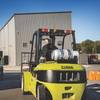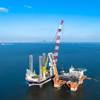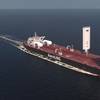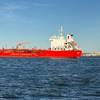Mothballed Vessels SE Asia Reflect Oil Slump Pain
Around 1,300 offshore support vessels lying idle worldwide.
Not everyone in shipping is bemoaning the industry's worst crisis in living memory: a cluster of companies that help preserve equipment and provide security for vessels parked around southeast Asia are busier than they have been for years.
A popular lay-up anchorage near Indonesia's Batam island, a short hop from Singapore, is growing crowded, and firms such as Ocean Shipcare and Brubay Shipcare are running out of space at another at Brunei Bay, near Labuan, off northern Borneo.
"Where do we go next? It's a good question, because we are trying to explore some other areas also," said Kanen Senasendram, base manager at Ocean Shipcare, which operates in Brunei Bay. He says he may need to hire more staff.
The industry is battling chronic oversupply, languishing oil prices and lacklustre container shipments as China's weaker growth weighs on global trade.
And the worst is yet to come this year, as large deliveries loom of vessels - such as those that tow oil rigs or ships that service drilling units - ordered during boom times in 2013-2014.
Wilhelmsen Ship Management, part of Norwegian-based global shipping and logistics group Wilh. Wilhelmsen Holding ASA , said it has about 60 ships in its lay-up care in Brunei Bay: the highest since the depths of the global financial crisis in 2009.
"This is the busiest I have seen the lay-up industry for a long time, probably since at least 1993," said Phil Shearer, managing director of shipping services firm Marine Assurance.
"1993 was bad, but the container and bulk markets were not also down."
OIL GLUT
Soaring output has left global oil markets awash with crude, causing traffic jams of tankers at ports in the Middle East, China and global storage hub Singapore, as buyers take advantage of cheap fuel.
But the glut has also driven oil prices down by up to 70 percent since 2014, making deepwater drilling unprofitable and prompting companies to cut back drastically on new exploration.
That has sharply reduced demand for offshore vessels such as drillships, and also for oil rigs.
While some are stacking up in anchorages around the North Sea, West Africa and the United States, the biggest lay-up hub is in Southeast Asian waters around Singapore, a location free from cyclonic storms due to its proximity to the equator.
About 1,300 offshore support vessels are lying idle worldwide, among them about 600 platform supply vessels (PSVs) and anchor handling tug supply vessels (AHTS), Lee Keng Lin, chief operating officer at PACC Offshore Services Holdings (POSH) told Reuters.
Most of the ships clogging these maritime parking lots are in so-called cold lay-up, meaning they are basically shut down and their crew signed off - a tacit admission from the owners that they do not expect any work for them for at least a year.
For companies with strong balance sheets the market turmoil represents an opportunity to replace old fleets cheaply, Marine Assurance's Shearer said.
STACK OR SCRAP?
"Cold stacked" vessels still require maintenance - from dehumidifying interiors and greasing exposed metal to putting security guards on board.
But for certain offshore support vessels (OSVs) that can cost up to $9,000-a-day to operate, ship management company Thome Group estimates running costs can be cut by 80 percent.
Currently 5,480 such vessels are in operation, totalling 10.1 million deadweight tonnes according to Clarkson, the British shipping services firm. Another 450 vessels, equivalent to 12.5 percent of the current fleet in tonnage are on order, with the majority set for delivery this year.
At the same time, charter rates are tumbling, hitting companies such as POSH and Pacific Radiance. Average charter rates for a large anchor handling OSV are down to about $16,000 per day, less than half the level in 2014, Clarkson data showed.
"The problem is the oversupply. There is a lot old tonnage out there. And what has to happen is - people need to scrap," said Phillip Chamberlain, chief operating officer at Thome Offshore Management.
But that is easier said than done, as there is very little scrap value in OSVs. A medium-sized OSV could yield around 2,000 tonnes of scrap metal, compared with 42,000 tonnes for a very large crude carrier (VLCC) - a difference of between $500,000 and $11 million based on current scrap prices, shipping data showed.
Crude prices have rebounded about 85 percent since hitting 12-year lows of around $27 a barrel in the first quarter, supported by falling U.S. production, and climbed above $50 a barrel last week for the first time in 2016.
That could bring some offshore vessels back into service. A recovery in oil prices to $65-70 a barrel would start to reactivate idled vessels, said shipbroker Banchero Costa.
Still prices remain less than half their level in mid-2014 and world oil supply remains in a glut.
For now, Ocean Shipcare's Senasendram is requesting the authorities for more space to stack ships.
"Most of the owners know that Brunei Bay is full. But some owners still send enquiries, for them we have to say: sorry. They have to find other places."
Reporting By Keith Wallis and Aradhana Aravindan






